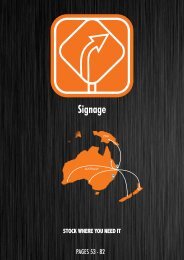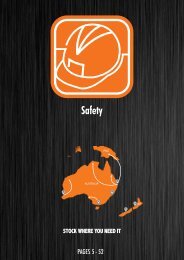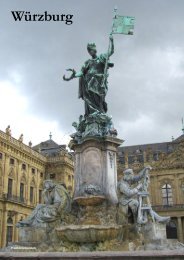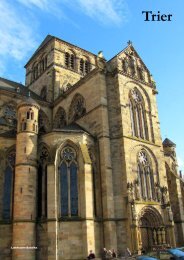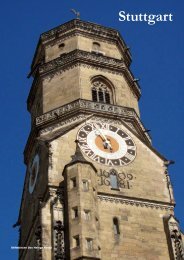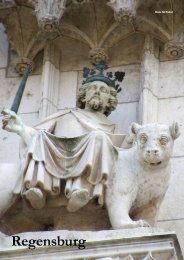Raven Guides: Germany - Potsdam
You also want an ePaper? Increase the reach of your titles
YUMPU automatically turns print PDFs into web optimized ePapers that Google loves.
The Romantic ideals of Karl Friedrich Schinkel’s later<br />
architecture made Schloß Babelsberg (1833) the first of<br />
the continent’s Neogothic palaces, influenced by<br />
Schinkel’s travel in Britain and notions associating<br />
Romanticism with German unity. The palace was a<br />
summer residence for the crown prince, later Wilhelm I,<br />
whose princess Augusta took firm views on the project,<br />
arguing with both Schinkel and Lenné when it came to<br />
park matters. The prince Hermann von Pückler-Muskau<br />
was responsible for much of the garden layout. The<br />
palace is being restored in a €10 million project<br />
expected to last until the end of 2015. The forecourt area<br />
provides a view over Glienicker Brücke and the lakes.<br />
Take bus 694 or the Wassertaxi to Schloß Babelsberg.<br />
The Neogothic Flatowturm (1856) was designed by<br />
Johann Heinrich Strack for the emperor William I with a<br />
medieval gate tower in Frankfurt as a model. The tower,<br />
used as guest accommodation, continued the <strong>Potsdam</strong><br />
building tradition of erecting buildings offering a view<br />
from lofty locations. As its moat the tower used the<br />
water storage for Park Babelsberg. The 46m tower can<br />
be climbed (May-Oct Sa-Su<br />
10-18, €2) for its city and lake<br />
view. Just to the north is the<br />
Gerichtslaube, a transplanted<br />
fragment of the medieval Berlin<br />
Rathaus. Take bus 694 or the<br />
Wassertaxi to Schloß Babelsberg.<br />
The arched steel Glienicker Brücke (1907) across<br />
the Havel at the north end of <strong>Potsdam</strong> was used for<br />
a known handful of prisoner exchanges at the Cold<br />
War frontier and hence will always be regarded as the<br />
bridge of spies. At this isolated spot the border was a<br />
simple line across the middle of the bridge (marked<br />
by a plaque today), though carefully watched. Here<br />
the U-2 reconnaissance pilot Francis Gary Powers was<br />
handed back to US officials in 1962. By this time the<br />
original structure, blown up during World War II, had<br />
been almost completely rebuilt. Other exchanges were<br />
set here in the pages of popular espionage fiction.<br />
Take tram 93 to Glienicker Brücke. An exhibition on<br />
the bridge’s history is in the city (see Museums).<br />
extra) but there are deals available including<br />
four nights for the price of three as well as<br />
apartments. Take S7 to <strong>Potsdam</strong>-Babelsberg<br />
and walk north on Karl-Liebknecht-Straße or<br />
take bus 694 to Spindelstraße.<br />
Another Babelsberg option is the small<br />
Pension am Findling (tel 0331-742064, www.<br />
pension-am-findling.de) at Großbeerenstraße<br />
105, with high-season singles/doubles including<br />
breakfast at €47/74 (€41/62 without<br />
breakfast). Between November and February<br />
rates fall to €42/64 (€36/52 without breakfast).<br />
Extra beds are €15 and children under 4 stay<br />
free. Parking is also free and bicycles can be<br />
hired at €5 per day or €20 per week. Take bus<br />
601 or 619 to Eichenweg.<br />
The DJH hostel is Jugendherberge<br />
<strong>Potsdam</strong>-Haus der Jugend (tel 0331-<br />
5813100, email jh-potsdam@jugendherberge.<br />
de) at Schulstraße 9 immediately south of the<br />
Babelsberg station with beds and breakfast<br />
starting at €17 in low season and €23 in high<br />
season. Schulstraße is reached at the east<br />
end via Wattstraße or the east end via Karl-<br />
Liebknecht-Straße.<br />
The pyramid near Marmorpalais was<br />
used for food storage.<br />
MUSEUMS & GALLERIES<br />
<strong>Potsdam</strong> Museum (Tu-W & F 10-17, Th 10-19, Sa-Su 10-18, €5/3)<br />
in the Altes Rathaus, Am Alter Markt 9, combines city history and art<br />
with changing exhibitions. Take tram 91, 92, 93 or 96 to Alter Markt.<br />
Another component of the museum is the Gedänkstätte<br />
Lindenstraße 54 (Mar-Dec Tu-Su 10-18, Jan-Feb Tu-Su 10-17,<br />
€3/2), a memorial in the Kommandantenhaus at that address to<br />
victims of political oppression and violence. The building was used<br />
as a political prison, first during World War II and later by the GDR<br />
government and the KGB. Cells and the prison yard can be viewed.<br />
Take tram 91, 94 or 98 to Dortustraße.<br />
Haus der Brandenburgisch-Preußischen Geschichte (Tu-F<br />
10-17, Sa-Su 10-18, €4.50/3.50) in the Kutschstall, Am Neuen<br />
Markt 9, has a standing exhibition on the history of Brandenburg<br />
and Prussia and the nature and significance of the Prussian military<br />
heritage. Take tram 91, 92, 93 or 96 to Alter Markt.<br />
An exhibition on the history of Glienicker Brücke (M-F 10-16,<br />
entry free) is at the Bundesvermögensamt, Berliner Straße 89<br />
(enter through reception). Take tram 93 to Glienicker Brücke.<br />
Filmmuseum <strong>Potsdam</strong> in the old Marstall building at Breite<br />
Straße 1 has collections on the history of Babelsberg film studios<br />
over a century, film technology and the film history of the GDR. Films<br />
are shown some days. The museum was expected to be closed for<br />
renovation until at least April 2014. Take tram 91, 92, 93 or 96 to<br />
Alter Markt.<br />
Museum Alexandrowka (Tu-Su 10-18, €3.50/3, children under 14<br />
free) in the old warden’s house at Russische Kolonie 2, one of the<br />
restored heritage timber buildings of the 1820s, covers the history of<br />
<strong>Potsdam</strong>’s Russian enclave. Mid May-mid Sep the museum is open<br />
Fridays to 21.00. Take tram 92 or 96 to Puschkinallee.<br />
Nowaweser Weberstube Museum (Tu & Th 13-16, donations<br />
requested), Karl-Liebknecht-Straße 23, displays artefacts from the<br />
weavers’ settlement of Nowawes, populated by immigrants from<br />
Bohemia from the mid 18th century. Take tram 94 or 99 or bus 601,<br />
690, 693 or 694 to Rathaus Babelsberg.<br />
The Bildergalerie (Tu-Su 10-18, €6/5 with audio guide) was<br />
Frederick the Great’s royal collection of paintings and many of the<br />
works he admired remain in the gallery he ordered built. Others<br />
have been included from Prussian palaces. Take bus X15 or 695 to<br />
Schloß Sanssouci.<br />
Museum im Güldenen Arm (W-Su 12-18,<br />
donation requested) in the half-timbered<br />
building at Hermann-Elflein-Straße 3 has a<br />
blend of artworks with a regional flavour,<br />
including ceramics. Take bus 603 or 609 to<br />
Mauerstraße.<br />
Natural history from the region is exhibited<br />
at the Naturkundemuseum (Tu-Su 9-17, €4, visitors 12-18 €2,<br />
children 6-12 €1), Breite Straße 13. The permanent collection<br />
includes an aquarium. The museum is also open the first Monday<br />
each month. Take bus X15 or 606 to Naturkundemuseum.<br />
<strong>Potsdam</strong> 8 - RAVEN TRAVEL GUIDES GERMANY








